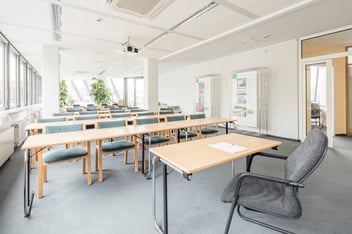7 Ways to Prep for Extended Breaks with Facility Management Software
Educational facilities can use the features of a facilities management solution such as preventive maintenance, planned events, and interactive floor plans to prepare for and return from extended breaks, like summer vacation. Here are seven examples of how educational facilities can implement helpful measures:
1. Create Preventive Maintenance (PM) Schedules
Develop a comprehensive maintenance schedule that includes routine inspections, servicing, and repairs for various systems and equipment in the facility. This schedule should cover all essential areas such as electrical systems, HVAC, plumbing, and building structures.
2. Conduct Pre-Break Inspections
Prior to a break, like for summer vacation, perform thorough inspections of the entire facility to identify any existing maintenance issues. This can involve checking for leaks, faulty electrical connections, HVAC problems, damaged fixtures, or any other potential issues that may require attention.
3. Address Immediate Issues
If any urgent maintenance issues are discovered during the pre-break inspections, prioritize their repairs or replacements before the break begins using corrective work orders. Promptly fixing problems like water leaks, malfunctioning equipment, or safety hazards can prevent further damage and ensure a smooth start when the facility reopens.
4. Review and Update Emergency Plans
Evaluate the existing emergency response plans and update them if necessary, using a system like SMARTPRINTS. This includes reviewing evacuation procedures, updating contact information, and ensuring that all staff members are familiar with their roles and responsibilities in case of an emergency.
5. Implement Energy-Saving Measures
Take steps to conserve energy during the extended break. This can involve adjusting thermostat settings, turning off unnecessary lighting, unplugging non-essential electrical devices, and utilizing energy-saving features or timers on equipment where applicable.
6. Communicate Maintenance Protocols
Clearly communicate maintenance protocols and guidelines to team members, faculty, and staff using Planned Events. Make sure that everyone understands their responsibilities and knows how to report maintenance issues that may arise during the break.
7. Keep Detailed Records
Maintain detailed records of all maintenance activities, including inspections, repairs, servicing, and upgrades. This documentation can help track the facility’s maintenance history, identify recurring issues, and inform future maintenance planning.
By implementing proactive measures, educational facilities can ensure that their infrastructure remains in good condition, minimize unexpected disruptions, and create a safe and conducive learning environment when students and staff return from extended breaks like summer vacation.
.png?width=268&height=52&name=f1-logo2%20(1).png)



